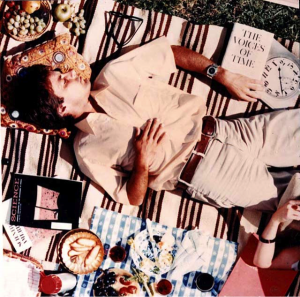Powers of Ten
Powers of Ten and Cosmic View—Seeing, Knowing and Sensory Experience
This is the scale of human companionship, conversation, touch: A man is asleep on a warm October day.
Around him are necessities and pleasures for mind and body. Between this image and the next frame inward, the
size of the image would for once match the size of what it represents. “Of all things, man is the measure,”
wrote Protagoras the Sophist.
—Powers of Ten, Charles and Ray Eames
This image, and quotation, above, are taken from the 1968 film Powers of Ten by Charles and Ray Eames.
The short film takes the viewer on a journey in order to explain not only the mathematics of exponential growth
but also how human senses, sight in particular, are extended through science and technology. The film’s
camera pulls back and zooms in on the universe, showing the inner-cellular to the extra terrestrial. The film
begins, pauses mid-way, and ends, with this image as a touchstone, showing the human scale: 100 —
“the scale we know best, our own,” the film’s narrator remarks.
In this image, a couple are having a picnic. Interestingly, as this is meant to illustrate the scale of the everyday,
all the senses are depicted—particularly through the use of food. The world on a picnic blanket. As a
visual, the designed patterns contrast against the natural green lawn. The food not only looks appetizing
but a viewer can imagine the scents and tastes experienced while eating outdoors. The woman touches
the man, resting against his leg. While the scene appears serene and silent—he naps while she reads a magazine—
a picture of a clock is shown (one can imagine the quiet ticking), and a book is visible
on the blanket, entitled, Voices of Time, a reminder that this quotidian scale is also the realm of voices
projected and heard. (The book itself, edited by J.T. Fraser, is an edited anthology of essays on the
nature of time from the sciences and humanities, its appearance also making reference to the role
that time’s passage plays in thinking about measuring the universe spatially).
As the film progresses, the viewer is taken on a “journey,” according to the Eames’s, between galaxies
and atoms, to present “the relative size of things in the universe, and the effect of adding another zero.” (19)
The galaxies can be seen as the camera pulls back—the positive exponents—all the way to 1025 metres
(approximately 1 billion light years). The atomic structures zoom in to 10-16 metres (the scientific unit of measurement
is the Fermi). At the time of the film’s making, 10-16 fades to nothingness. Today, quark particles have been found.
Scientific discovery extends the journey further.
The Eames Office based the film on a children’s book written in 1957 by Dutch educator Kees Boeke.
His book, Cosmic View: The Universe in 40 Jumps, had been widely released and well known. Boeke,
in his introduction, writes:
We all, children and grownups alike, are inclined to live in our own little world, in our immediate surroundings,
or at any rate with our attention concentrated on those things with which we are directly in touch. We tend
to forget how vast are the ranges of existing reality which our eyes cannot directly see, and our attitudes may become
narrow and provincial. We need to develop a wider outlook, to see ourselves in our relative position
in the great and mysterious universe in which we have been born and live. (4)
His book, written for children and with drawings made by his students, also puts forward his views on
social reform, speaking not only of eye-sight, but also of oversight, a larger sensory and humanist understanding
of the universe: “The problem, however, is that primitive man at first tends to use the power put in his hands
for himself, instead of spending his energy and life for the good of the whole growing human family, which
has to live together in the limited space of our planet…In this education the development of a cosmic view
is an important and necessary element; and to develop such a wide, all-embracing view, the expedition we
have made in these ‘forty jumps through the universe’ may help just a little.” (48).
Boeke’s commentary moves beyond that of the however poetic, mid-century modern fascination with
science found in Powers of Ten, and into a broader cultural and environmental analysis. His understanding
of visual culture has strong Dutch historical precedents dating back to the 17th century, from Antonie van
Leeuwenhoek, inventor of the microscope, and his contemporary, painter Johannes Vermeer, along with the obsessive artisanal
century mapmaking industry, looking at landscapes from multiple levels of scale. Both Cosmic View and Powers of Ten,
however, investigate the difference between what the human eye can see, unadorned, and what is visible within a larger view of
the universe, illustrating the difference between knowing and seeing.
Dana Samuel, PhD Candidate, Humanities Doctoral Program, Concordia University
References:
Boeke, Kees. Cosmic View: The Universe in 40 Jumps. New York: John Day Company. 1957. Print.
Charity, Mitchell. Cosmic View by Kees Boeke. Web. www.vendian.org/mncharity/cosmicview/
Eames, Charles and Ray. Powers of Ten. 1968. Film.
Morrison, Philip, Phylis Morrison and the Office of Charles and Ray Eames. Powers of Ten:
About the Relative Size of Things in the Universe. New York: Scientific American, 1982.


